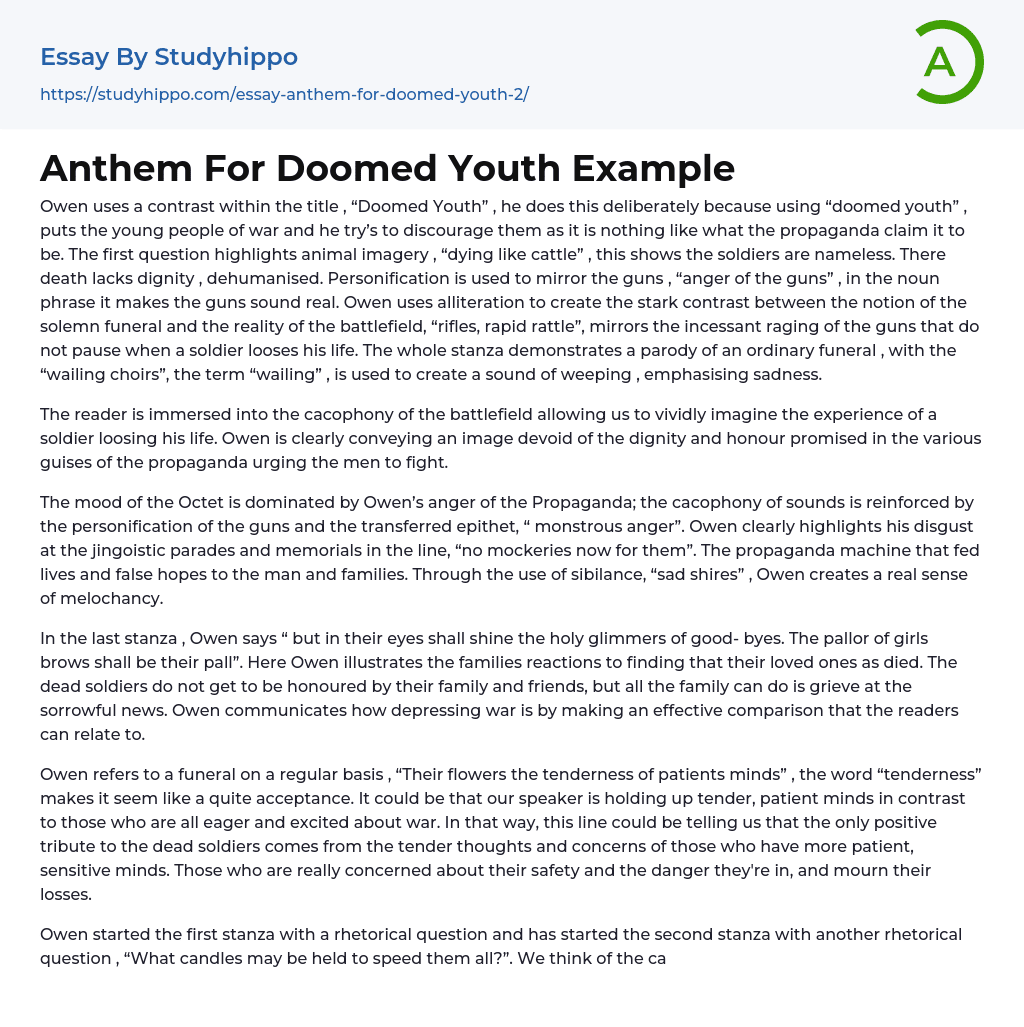Owen's choice of the title "Doomed Youth" aimed to juxtapose the idealized perception of war with its harsh reality, discouraging young individuals from enlisting. The poem begins with a question using animal imagery, dehumanizing soldiers even in death. Additionally, guns are personified and described as angry, adding realism. Alliteration highlights the contrast between traditional funerals and battlefield conditions. For instance, phrases like "rifles, rapid rattle" echo combat gunfire persisting after a soldier's death. Ultimately, this stanza parodies funeral customs through imagery such as "wailing choirs," evoking sadness through "wailing."
Owen skillfully transports us to the turbulent battlefield, allowing us to vividly envision the distressing ordeal of a soldier's demise. With his words, Owen exposes a harsh truth that contradicts the noble and honorable image portrayed by propaganda urging men
...to join the fight.
The Octet showcases Owen's anger at the Propaganda, with the dominant mood being one of frustration. The cacophony of sounds is exemplified by the personification of the guns and the use of the transferred epithet, "monstrous anger". Owen expresses his clear disdain for jingoistic parades and memorials, stating that there are "no mockeries now for them". The propaganda machine deceived men and their families with false hopes and lives. Through his use of sibilance in "sad shires", Owen creates a somber atmosphere.
Owen presents the families' response to learning about their loved ones' deaths in the final stanza. Instead of being honored, the soldiers are mourned by their family and friends. Owen successfully communicates the sorrowful essence of war through a relatable analogy.
Owen often refers to a funeral in his work, symbolizing the "tenderness o
patients minds" and conveying a serene acceptance. This suggests that the speaker is highlighting the contrast between gentle and patient minds versus those who enthusiastically support war. Thus, this statement implies that only individuals with patient and sensitive minds can truly honor fallen soldiers. These are the people who genuinely care about others' well-being, mourn their losses, and recognize the risks they encounter.
Owen starts the poem with a rhetorical question in the first stanza, and in the second stanza, he poses another rhetorical question: "What candles may be held to speed them all?". These candles symbolize the elaborate ceremonies we organize to honor those who died in war. However, we comprehend that lighting a specific candle cannot truly help the soldier or their families.
In summary, Owen uses a somber tone in the conclusion of the poem, incorporating the phrase "And each slow dusk, a drawing down of blinds." The term "slow" signifies the gradual deceleration of the poem's pace in the second stanza, making this line particularly sluggish and subdued. Furthermore, this line maintains perfect iambic pentameter, further heightening the poem's tempo. The meter lends a mournful rhythm to the line that effectively conveys sadness. The expression "drawing down of the blinds" serves as a symbol for death, where families who have lost their young men close their blinds similar to closing and ending a life.
- Book Summary essays
- Metaphor essays
- Reader essays
- Rhyme essays
- Literary devices essays
- Villain essays
- Books essays
- Genre essays
- Literary Criticism essays
- Writer essays
- Protagonist essays
- Simile essays
- Poem essays
- Book Report essays
- Book Review essays
- Greek Mythology essays
- Plot essays
- Tragic Hero essays
- Coming of Age essays
- Play essays
- Rhetoric essays
- Rhetorical Question essays
- Translation essays
- Understanding essays
- Reason essays
- Character essays
- Letter essays
- American Literature essays
- Literature Review essays
- Utopia essays
- Poetry Analysis essays
- Dante's Inferno essays
- Between The World and Me essays
- Incidents in The Life of a Slave Girl essays
- Flowers for Algernon essays
- Myth essays
- Everyday Use essays
- Boo Radley essays
- Genesis essays
- Richard iii essays
- Alice in Wonderland essays
- On the road essays
- Ozymandias essays
- The Nightingale essays
- Holden Caulfield essays
- Animal Farm essays
- 1984 essays
- A Hanging essays
- Shooting An Elephant essays
- A Tale Of Two Cities essays




